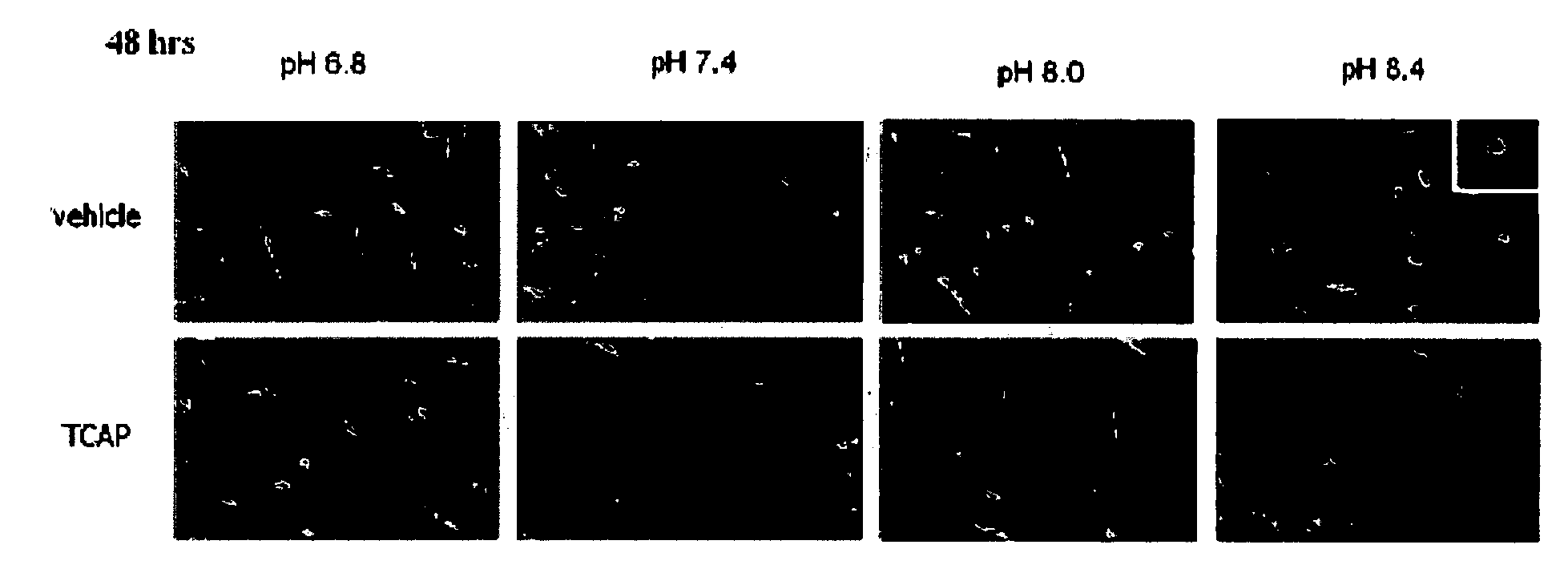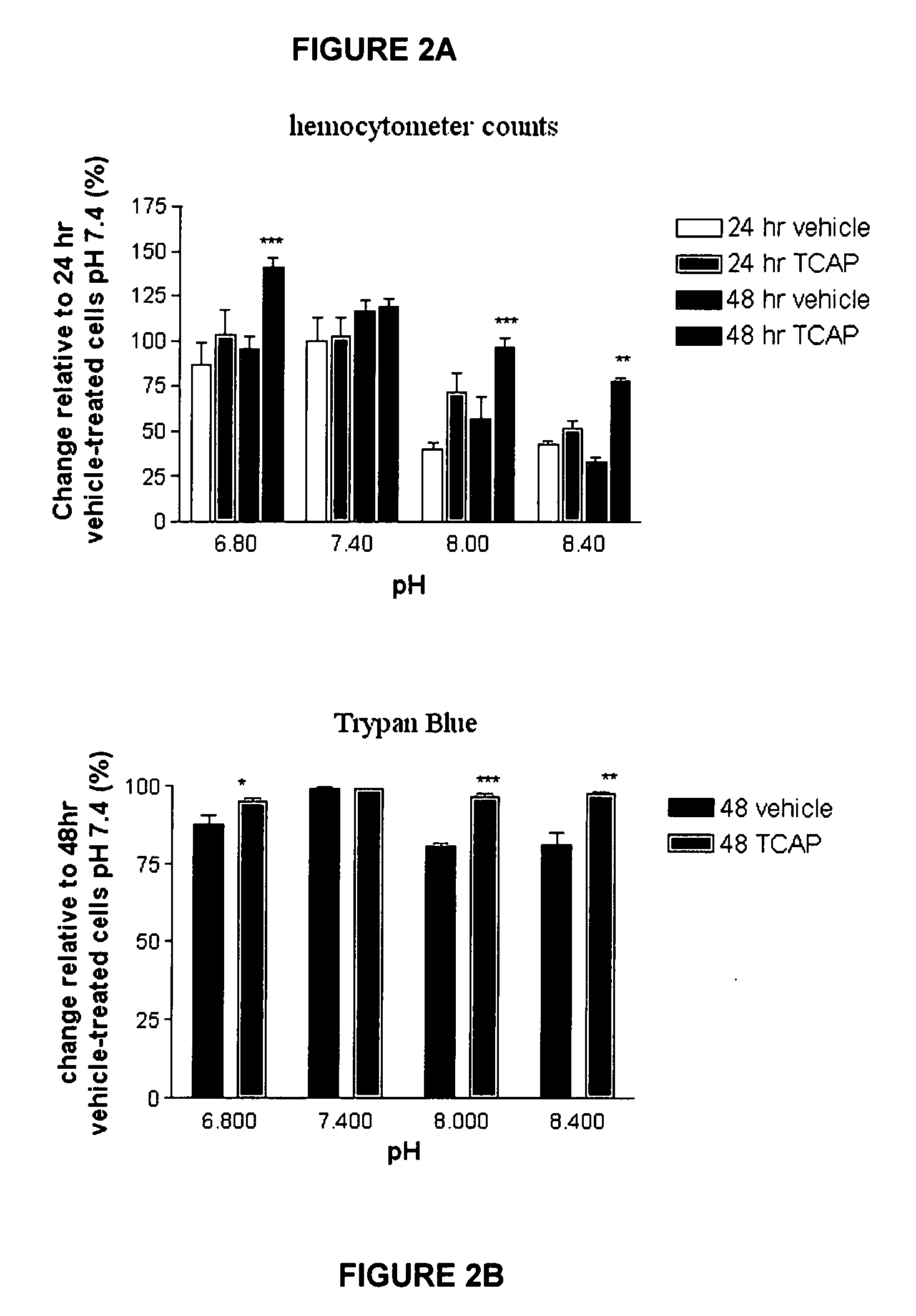Method for inhibiting neuronal cell death
- Summary
- Abstract
- Description
- Claims
- Application Information
AI Technical Summary
Benefits of technology
Problems solved by technology
Method used
Image
Examples
example 1
Peptide Synthesis
[0078] Mouse TCAP-1 (such as SEQ. ID. NO. 38) was prepared by solid phase synthesis as previously described (Qian et al., 2004). The peptide was solubilized in phosphate buffered saline (PBS) at a concentration of 2×10−7 M before being diluted in the appropriate medium.
example 2
Cell Morphology Analysis
[0079] The effect of TCAP-1 on cell morphology was conducted using the N38 cells immortalized mouse hypothalamic cell line(Belsham et al, 2004). Cells were grown in six-well culture plate with 2 ml of Dulbeco's Modified Eagle Medium (DMEM) with high glucose, L-glutamate, 25 mM HEPES buffer, pyridoxine hydrochloride in the absence of sodium pyruvate, 5 ml penicillin with 10% fetal bovine serum (FBS) at pH 7.4 (all from Gibco-Invitrogen, Burlington, Canada).
[0080] At 24 and 48 hrs, the medium was replaced with medium buffered at pH 6.8, 7.4, 8.0 or 8.4. Half of the cell groups received (2×10−7 M) TCAP-1, whereas the other half received phosphate buffered saline (PBS) pH 7.4 containing 8 g NaCl, 0.2 g KCl, 1.4 g Na2HPO4, 0.2 g KH2PO4 in. 800 mL ddH2O. For all groups, 4 replicates were run. Digital pictures were taken at 24, 48 and 72 hrs using an Olympus IX&1 inverted microscope at a magnification of 200× and analyzed using LabWorks 4.0 Image Acquisition and A...
example 3
Effect of TCAP on Cell Proliferation and Viability
[0082] The effect of TCAP-1 on cell proliferation at each pH was examined by direct counts using a hemocytometer and indirectly by assessing mitochondrial activity using a colorimetric MTT (3-[4,5-dimethylthiazol-2-yl]-2,5-diphenyl tetrazolium bromide) assay on cultured N38 cells. For hemocytometer counts, the cultures were incubated for 24 and 48 hrs. The cells were suspended using 1 ml of 0.25% Trypsin with EDTA (Gibco-Invitrogen, Burlington, Canada), centrifuged at 1600 RPM for 4 min, and resuspended with PBS. The cells in 50 μl aliquots were vortexed and counted on a hemocytometer.
[0083] The proportion of viable cells in the samples was determined by measuring Trypan Blue uptake. At 48 hrs, the cells from the four pH treatments were suspended using 1 ml of Trypsin EDTA, centrifuged at 1600 RPM for 4 min and resuspended in 1 ml of BSS (Hank's Balanced Salt Solution) (Sigma, St. Louis). An aliquot of 0.5 ml of 0.04% Trypan Blue s...
PUM
| Property | Measurement | Unit |
|---|---|---|
| Acidity | aaaaa | aaaaa |
| Cell death | aaaaa | aaaaa |
| Energy | aaaaa | aaaaa |
Abstract
Description
Claims
Application Information
 Login to View More
Login to View More - R&D
- Intellectual Property
- Life Sciences
- Materials
- Tech Scout
- Unparalleled Data Quality
- Higher Quality Content
- 60% Fewer Hallucinations
Browse by: Latest US Patents, China's latest patents, Technical Efficacy Thesaurus, Application Domain, Technology Topic, Popular Technical Reports.
© 2025 PatSnap. All rights reserved.Legal|Privacy policy|Modern Slavery Act Transparency Statement|Sitemap|About US| Contact US: help@patsnap.com



